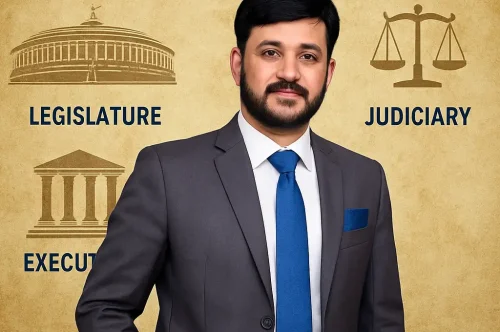Preamble & Basic Structure Doctrine Explained | Adv. Prakash Sharma

Preamble & Basic Structure Doctrine: Constitutional Identity of India
By Adv. Prakash Chand Sharma
Chartered Engineer | High Court Advocate | CAO
Founder – Zumosun Universe, Techlam Legal Solutions, JPSD Taxsun LLP
Powered by: TheLegalCourt.com | TheLegalBank.com
Introduction
The Preamble and Basic Structure Doctrine are the constitutional pillars that define the identity, purpose, and inviolable features of the Indian Constitution.
They shape India’s legal system, governance philosophy, and judicial review framework.
For professionals, corporates, institutions, and citizens, understanding these concepts is critical because they directly influence:
-
Legislative power
-
Government actions
-
Judicial decisions
-
Public policy
-
Fundamental rights protection
-
Constitutional amendments
These principles form the soul and framework of Indian democracy.
1. The Preamble – Identity & Vision of the Constitution
The Preamble declares India as:
“Sovereign, Socialist, Secular, Democratic, Republic.”
It sets forth four essential objectives:
1. Justice:
Social, economic, and political justice.
2. Liberty:
Freedom of thought, expression, belief, faith, and worship.
3. Equality:
Equality of status and opportunity.
4. Fraternity:
Assuring dignity of the individual and unity & integrity of the nation.
2. Legal Nature & Significance of the Preamble
✔ Preamble is NOT enforceable, but
✔ It is a guiding light for interpreting the Constitution.
The Supreme Court treats the Preamble as the foundation for constitutional philosophy.
Key Relevance in Practice:
-
Used for interpretation of laws
-
Used to check legislative intent
-
Influences public policy and governance
-
Supports judicial review
-
Helps resolve constitutional ambiguities
Case Law: Berubari Union Case (1960)
Initially said: Preamble is NOT a part of the Constitution.
Case Law: Kesavananda Bharati (1973)
Reversed — Held that Preamble IS a part of the Constitution and essential to its interpretation.
3. Amendment of the Preamble
The Preamble was amended only once:
42nd Constitutional Amendment (1976):
Inserted the words:
-
Socialist
-
Secular
-
Integrity
These additions strengthened the constitutional vision.
4. Basic Structure Doctrine – The Judicial Safeguard
The Basic Structure Doctrine ensures that no government, Parliament or majority can destroy the essential character of the Constitution.
Origin:
Kesavananda Bharati v. State of Kerala (1973)
A landmark 13-judge bench held:
“Parliament can amend any part of the Constitution,
but cannot destroy its basic structure.”
5. What Forms Part of the Basic Structure?
The Supreme Court has not given an exhaustive list, but key features include:
✔ Supremacy of the Constitution
✔ Rule of Law
✔ Judicial Review
✔ Separation of Powers
✔ Secularism
✔ Democracy & Free Elections
✔ Federalism
✔ Independence of Judiciary
✔ Freedom & Dignity of the Individual
✔ Parliamentary System
✔ Equality
✔ Basic Fundamental Rights
These cannot be amended or altered in a way that damages their core meaning.
6. Practical Importance of the Basic Structure Doctrine
For Citizens:
Protects rights from misuse of political power.
For Corporates:
Ensures stable legal environment and limits arbitrary policy changes.
For Governance Bodies:
Ensures administrative decisions remain constitutional.
For Judiciary:
Empowers courts to strike down unconstitutional amendments.
For Public Institutions:
Ensures fairness, transparency, and democratic accountability.
7. Key Judgments Strengthening Basic Structure
1. Indira Gandhi v. Raj Narain (1975)
Free and fair elections are part of basic structure.
2. Minerva Mills (1980)
Balance between Fundamental Rights and DPSP is essential.
3. S.R. Bommai (1994)
Secularism is part of basic structure.
4. Kihoto Hollohan (1992)
Judicial review of anti-defection laws upheld.
8. Commercial & Governance Relevance
✔ Corporate Law:
Judicial review protects businesses from unconstitutional regulations.
✔ Administrative Law:
Authorities must work within constitutional limits.
✔ Public Sector & Policy:
Governance must align with constitutional principles.
✔ Legal Tech & Compliance:
Frameworks must integrate constitutional protections.
Conclusion
The Preamble defines India’s constitutional identity, while the Basic Structure Doctrine ensures that this identity is never compromised. Together, they safeguard democracy, protect citizens, and provide a stable, consistent framework for governance and law.
These concepts are indispensable in legal practice, constitutional interpretation, public administration, corporate compliance, and judicial review.
Author
Adv. Prakash Chand Sharma
Chartered Engineer | High Court Advocate | CAO
Founder – Zumosun Universe, Techlam Legal Solutions, JPSD Taxsun LLP
Powered by: TheLegalCourt.com | TheLegalBank.com






